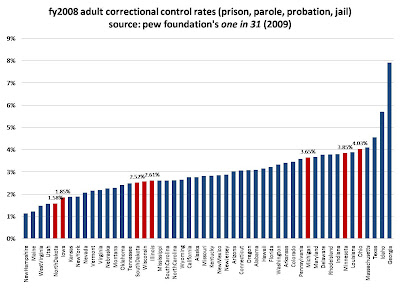the new pew foundation report, one in 31, the long reach of corrections, assembles some fascinating state-level data. below, i’ve graphed the “adult correctional control rates” for the 50 states. i’ve shaded some of the midwestern states red for easy comparability. notice how minnesota has a very high rate of correctional control? about 4% of the adult population is under supervision — mostly being supervised in the community while serving probation sentences.
 the next figure is based on the spending information in the pew report, taking corrections spending as a percentage of state general fund expenditures. although our correctional control rate is high, minnesota pays relatively little on corrections because probation is cheap relative to prisons (pew reports that about 82 percent of total corrections spending goes to prisons). i can’t vouch for the expenditure data here, since i haven’t used it or vetted it, but the correctional control figures look right to me. michigan is clearly an outlier, but i think this is due to data comparability problems (education spending is excluded from the gdp denominator).
the next figure is based on the spending information in the pew report, taking corrections spending as a percentage of state general fund expenditures. although our correctional control rate is high, minnesota pays relatively little on corrections because probation is cheap relative to prisons (pew reports that about 82 percent of total corrections spending goes to prisons). i can’t vouch for the expenditure data here, since i haven’t used it or vetted it, but the correctional control figures look right to me. michigan is clearly an outlier, but i think this is due to data comparability problems (education spending is excluded from the gdp denominator).

finally, i made a little scatterplot showing the correlation between spending as a percentage of state gdp and overall correctional control. i dropped michigan from the figure, but ran the correlation with and without it.
 i didn’t label every state, but you can get a sense for the overall patterns. minnesota (and alabama?) spend little, but have moderate to high control rates. georgia supervises a surprising 8 percent of the adult population, but spends a percentage of gdp comparable to low-control states like iowa or illinois. florida, arizona, and oregon all spend a great deal relative to their rates of correctional control. new hampshire and maine have few people under control, but still spend a fair percentage of state resources on them.
i didn’t label every state, but you can get a sense for the overall patterns. minnesota (and alabama?) spend little, but have moderate to high control rates. georgia supervises a surprising 8 percent of the adult population, but spends a percentage of gdp comparable to low-control states like iowa or illinois. florida, arizona, and oregon all spend a great deal relative to their rates of correctional control. new hampshire and maine have few people under control, but still spend a fair percentage of state resources on them.
i should repeat the caveat that i haven’t vetted these data, so i’m not sure whether we’ve really got reliable and valid information on all variables, or whether the information is consistently reported across states. nevertheless, i very much appreciate the sorts of questions that the pew report is raising. at minimum, it should spur some productive discussions about policy choices.

Comments